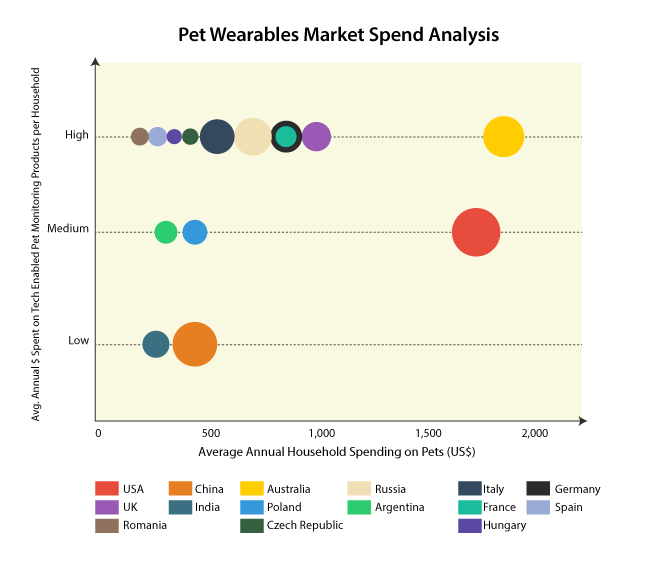Pet wearables – a booming industry set to grow even further

Safety concerns are fuelling the adoption of tracking technologies and sensors in the pet wearables market.
Tracking our lives and that of our pets
Technological innovations are transforming the way in which people go about their daily lives. The impact of technological advancements is not limited to humans alone – the way individuals care for their pets is also being influenced by the intervention of technology. Wearables, tracking various activities on a daily basis, are extremely beneficial for humans. But, in the case of pets, these could be transformational. Being able to receive data and information about their pets, helps owners to have a better understanding of their pets’ health, wellbeing and whereabouts. They can even help pet owners to better train their furry companions for situations when they have to be home alone.
Innovations driving sales
With a wide range of pet wearables featuring innovative functionalities penetrating the landscape, worldwide sales of pet wearables are likely to record an impressive CAGR of over 7% between 2018 to 2028. This represents a business potential worth nearly $3 billion (€2.59 billion). In addition, the pet wearables industry is characterised by research and development activities, which could translate into a massive influx of advanced products in the marketplace.
Not surprisingly, Mars Petcare, a leading player in the pet tracker business, announced a project named ‘Pet Insight Project’. This is a three-year study involving over 200,000 dogs across the US, with an objective of unleashing crucial links between pet activity, behaviour, and health. The project aims at leveraging technologies such as machine learning and data science to pave grounds for a new era of proactive pet care.
Monitoring pet health
The ease of collecting specific pet health metrics data is another key attribute of pet wearables that is fuelling interest in these products among veterinary professionals. The ongoing trend of healthier pet lives – focused on feeding and obesity control – has boosted the demand for activity monitoring wearables. With around 56% of dogs and 60% of cats clinically overweight (according to a recent clinical survey by the Association of Pet Obesity and Prevention) the demand for such wearables will continue to grow.
…and other things
In a bid to facilitate veterinarians in real-time decision making and offer them valuable information, leading pet wearables companies are now focusing on the development of devices integrated with cloud-based analytics. On the pet owner home front, manufacturers are looking to upgrade the quality of video cameras and treat dispensers to enable pet owners to interact with their pets through platforms such as Skype.
For instance, PetChatz® recently introduced PetChatz HD, a device allowing owners to FaceTime their pets, dispense treats and have two-way video chats.
Location tracking is a key feature that is becoming one of the preferred functionalities. Manufacturers are also integrating sensors into their products, thereby enabling pet owners to track activities of their pets via smartphones. Take Loc8tor: the company recently launched TabCat that incorporates a radio frequency receiver and audio and visual cues to find lost pet cats.
Last but not least, insurance and pet care companies are investing in the pet wearables market to offer collaborative services to pet owners. For instance, in 2017 multinational insurance company RSA invested in dog activity monitor company PitPatPet, to stimulate the use of smart devices in boosting the wellbeing of pets.
The impact of online
Simultaneously, buyer preference is undergoing a marked shift from modern trade and specialty stores to online retailers, where the choice of brands and products is unlimited. With favourable auto-replenishment programmes and minimum shipping costs, it is no surprise that customers looking for pet wearable devices are swiftly opting for online.
This shift in retail channel means that e-commerce
sales of pet wearables is foreseen to exceed
$1 billion (€0,86 billion) in revenues by end 2028.
What about the future of wearables?
It is clear that the pet wearables industry has undergone a significant growth in the US, as pet owners take to sophisticated technologies. In fact, the region holds a stellar business potential for pet wearables brands. Outside of the US, the pet wearables industry can expect a continued growth in the Asia Pacific area, China and India where the rapid penetration of the IoT is paving the way for new business opportunities.
However, one issue that needs to be tackled is inferior battery technology. The inclusion of ever more features on one device, means that the limits associated with lithium-ion battery technology are quickly being reached. This has led manufacturers to opt for the less-efficient, lead-acid and silicon-carbide batteries. Additionally, the high cost of pet wearables is acting as impediment for mass adoption of these useful devices. It is expected that manufacturers who focus on producing relatively affordable products, that also feature customer requirement-specific functional attributes, are likely to witness promising future prospects in this industry.
